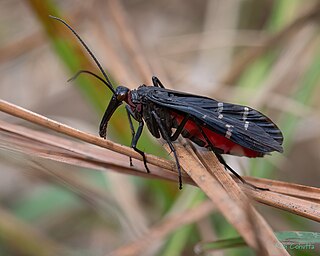
The Panorpodidae are a small family of scorpionflies. Of the two genera, Brachypanorpa occurs only in the United States, and Panorpodes occurs in East Asia, with a single species in California. Unlike their sister group Panorpidae, the family generally has short jaws, amongst the shortest of all mecopterans. Brachypanorpa is thought to be phytophagous, consuming the epidermis of soft leaves, and a similar diet is suggested for Panorpodes.
Panorpa ensigera is a species of common scorpionfly in the family Panorpidae. It is found in North America.

Panorpa lugubris, the mourning scorpionfly, is a species of common scorpionfly in the family Panorpidae. It is found in North America.
Gyascutus carolinensis is a species of metallic wood-boring beetle in the family Buprestidae. It is found in Central America and North America.
Narvesus carolinensis is a species of assassin bug in the family Reduviidae. It is found in the Caribbean Sea, Central America, North America, and South America.
Panorpa carolinensis is a species of common scorpionfly in the family Panorpidae. It is found in North America.

Camptonotus carolinensis, the Carolina leaf-roller, is a species of raspy cricket in the family Gryllacrididae. It is found in the eastern United States.

Phidippus carolinensis is a species of jumping spider in the family Salticidae. It is found in the United States and Mexico.

Habronattus carolinensis is a species of jumping spider in the family Salticidae. It is found in the United States and Canada?.
Panorpa floridana, the Florida scorpionfly, is a species of common scorpionfly in the family Panorpidae. It is found in North America.
Brachypanorpa oregonensis is a species of scorpionfly in the family Panorpodidae. It is found in western North America.

Brachypanorpa is a genus of scorpionflies in the family Panorpodidae. There are about five described species in Brachypanorpa.

Solenopsis carolinensis, the thief ant, is a species of ant in the family Formicidae.
Brachypanorpa sacajawea is a species of scorpionfly in the family Panorpodidae. It is found in western North America.
Boreus nivoriundus, known generally as the snow-born boreus or snow scorpionfly, is a species of snow scorpionfly in the family Boreidae. It is found in North America.
Panorpa choctaw is a species of common scorpionfly in the family Panorpidae. It is found in North America.

Acroneuria carolinensis, the Carolina stone, is a species of common stonefly in the family Perlidae. It is found in North America.
Panorpa hungerfordi is a species of common scorpionfly in the family Panorpidae. It is found in North America.
Panorpa insolens is a species of common scorpionfly in the family Panorpidae. It is found in North America.

Sophy I. Parfin was an American entomologist associated with the National Museum of Natural History.







